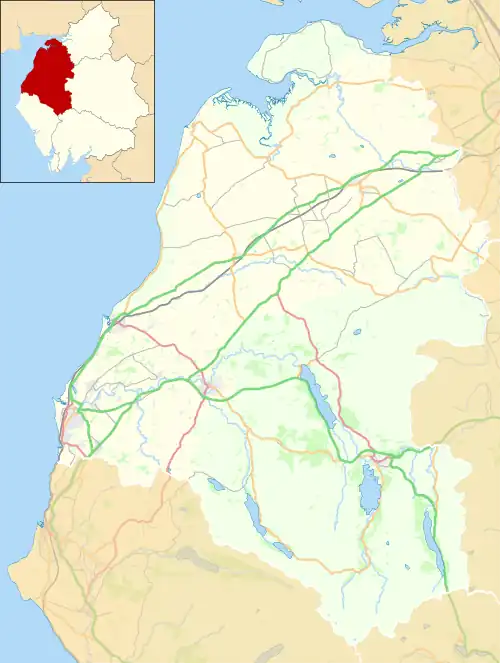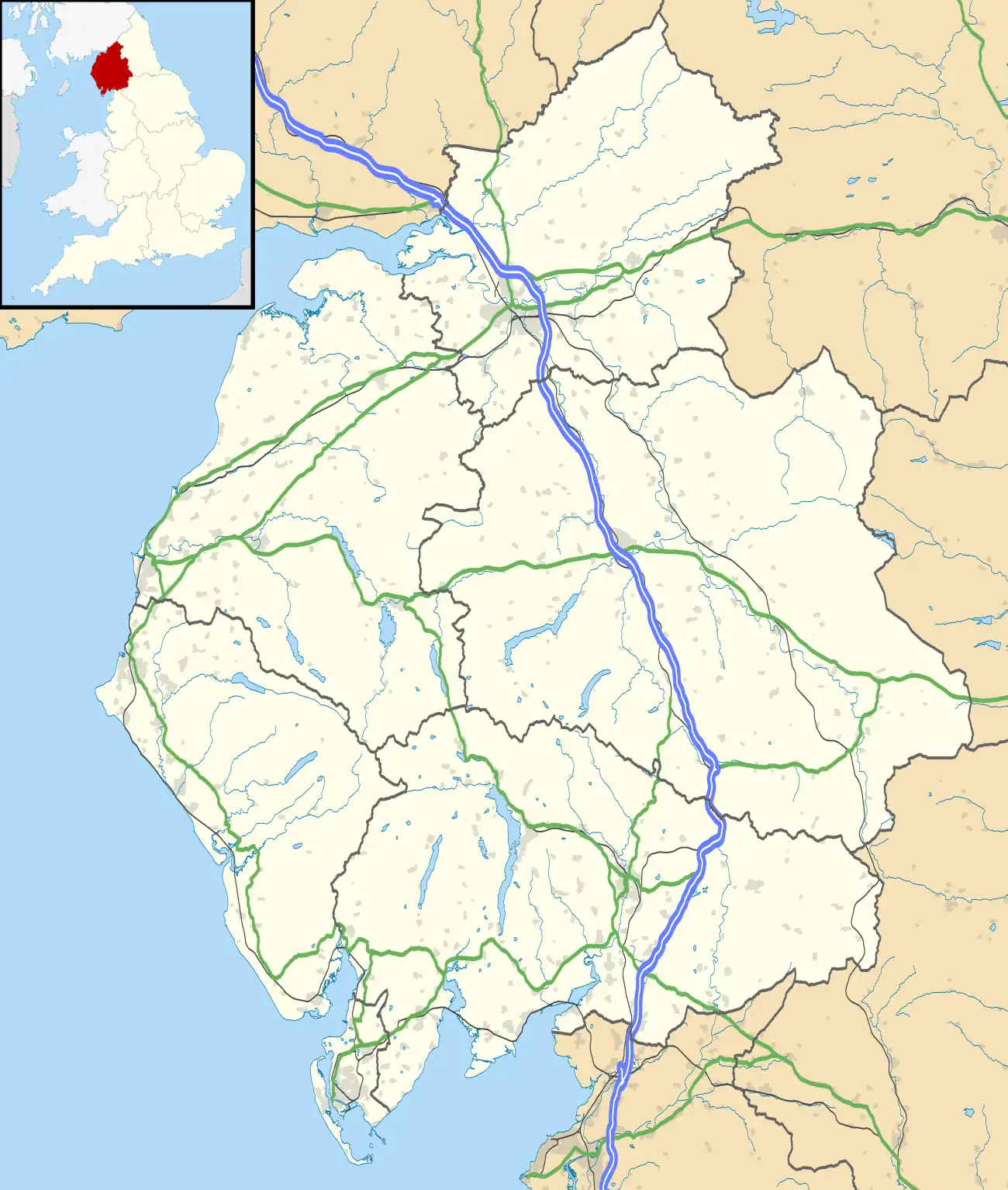Alauna (Maryport)
Alauna was a castrum or fort in the Roman province of Britannia. It occupied a coastal site just north of the town of Maryport in the English county of Cumbria (formerly part of Cumberland).
| Alauna | |
|---|---|
| Cumbria, England | |
 Senhouse Roman Museum, with its replica Roman watch-tower in the background. | |
| Coordinates | 54.720936°N 3.493978°W |
| Grid reference | NY03863724 |
 |
| Part of a series on the |
| Military of ancient Rome |
|---|
|
|
It was linked by a Roman road to the Roman fort and settlement at Derventio (Papcastle) to the southeast, and thence by another road northeast to the regional hub of Luguvalium (Carlisle).
In 2015 "Maryport's Mystery Monuments" was Research Project of the Year in the British Archaeology Awards.
Name
It has been established "beyond reasonable doubt" that the Roman name for Maryport was Alauna.[1] Alauna is a river name and the Roman fort stands on a hill north of the River Ellen.[2] The name Alauna appears securely just once – in the Ravenna Cosmography.[1] The Antonine Itinerary mentions a fort called Alone on the road from Ravenglass to Whitchurch but this cannot be Maryport, but is either a fort at Watercrook (on the river Kent near Kendal) or one at Low Borrowbridge (on the River Lune near Tebay).[1] The Notitia Dignitatum lists a fort called Alione, garrisoned by the Cohors III Nerviorum, which has been equated with both Alauna and Alone by different scholars.[1]
Character
The fort was established during the reign of the emperor Hadrian, around AD 122 [3] as a command and supply base for the coastal defences of Hadrian's Wall at its western extremity. There are substantial remains of the Roman fort, which was one of a series along the Cumbrian coast intended to prevent Hadrian's Wall being outflanked by crossing the Solway Firth. Geo-magnetic surveys have revealed a large Roman town surrounding the fort. An archaeological dig discovered evidence of a second, earlier, larger fort next to, and partially under the present remains.
Geophysical survey
TimeScape Surveys (Biggins & Taylor), supported by a grant from the Maryport Heritage Trust, conducted a magnetometry geophysical survey of the fort and its vicus (civilian settlement). Some targeted areas of resistivity survey were completed. The survey was conducted between May 2000 and September 2003 on land at Camp Farm, Maryport. Covering 72.5 hectares (170 acres), it is the largest geophysical survey carried out on the northern Roman frontier.
The survey revealed multi-period activity, together with the possible location of a Roman port or causeway. The fort had been robbed of stone to construct other buildings in the locality. The vicus was well-preserved and had a substantial road leading to the suspected Roman entrepôt. The field system surrounding the vicus was extensive and showed small 'market garden' plots, some containing buildings. The survey also detected a suspected Iron Age enclosure and elements of medieval buildings.
Museum and artefacts
The Roman fort site was owned from the 16th century by generations of the Senhouse family. The main building on the site was constructed as a naval artillery drill hall in 1885; it was converted into a museum (the Senhouse Roman Museum) in 1990.[4] The Senhouse family's collections are now housed in the museum. The numerous Roman artefacts include altars. The site has yielded more altars than any other in Britain, and the finds have been made over a long period of time, from Tudor times to the present century.
Altars
The altars are made of local sandstone. They were erected for ceremonies which appear to have taken place annually. The inscriptions give information about the fort and its inhabitants. One of the best known, now in the British Museum, has an inscription dedicated by Gaius Cornelius Peregrinus, a decurion (town councillor) from Saldae (present-day Bejaia in Algeria), who was tribunus (military commander) of the auxiliary garrison.[5]
Excavations beginning in 2011 have thrown more light on the altars. The archaeologists included Ian Haynes of Newcastle University and Tony Wilmott (who won the Archaeologist of the Year award in 2012).[6]
Where the altars originally stood is not known, but they were designed to stand in rows. They were possibly aligned in relation to a temple, and excavations have examined evidence for two temples.[7]
The 2011 excavation season revisited a site where 17 altars were found in pits in 1870. The circumstances of the altars' deposition have been reinterpreted and it is accepted that they were re-used in the foundations of a late-Roman building.[8] This suggests that religious beliefs at Alauna changed during the period of Roman occupation.[6]
Notes
- Jarrett, Michael (1976). Maryport, Cumbria: a Roman fort and its garrison. T. Wilson. pp. 15–16.
- Garlick, Tom (1976). Romans in the Lake Counties. Dalesman. p. 40.
- "Maryport (Alauna) Roman Fort".
- "About Senhouse Roman Museum". Senhouse Roman Museum. Retrieved 28 January 2018.
- Altar. British Museum. Retrieved July 10, 2014
- "Maryport's mystery monuments". Current Archaeology. 2014. Retrieved 14 August 2015.
- Roman Maryport - Roman Temples Project Archived 2015-09-06 at the Wayback Machine
- Robson, Ian. "I'm Digging the Dirt to Unearth the Roman Past". Sunday Sun - Newcastle-upon-Tyne. ncjMedia Ltd. 2012.
References
- Biggins, J. A. and Taylor, D. J. A., 2004b, The Roman Fort and Vicus at Maryport: Geophysical Survey, 2000 - 2004, in R. J. A. Wilson and I, Caruana (eds.), Romans on the Solway, CWAAS for the Trustees of the Senhouse Museum, Maryport, 102-133.
Further reading
- Roman Maryport and its setting : essays in memory of Michael G. Jarrett, edited by R. J. A. Wilson. Extra series, 28. Cumberland and Westmorland Antiquarian and Archaeological Society on behalf of the Senhouse Roman Museum, Maryport. 1997. p. 168. ISBN 1873124228.



